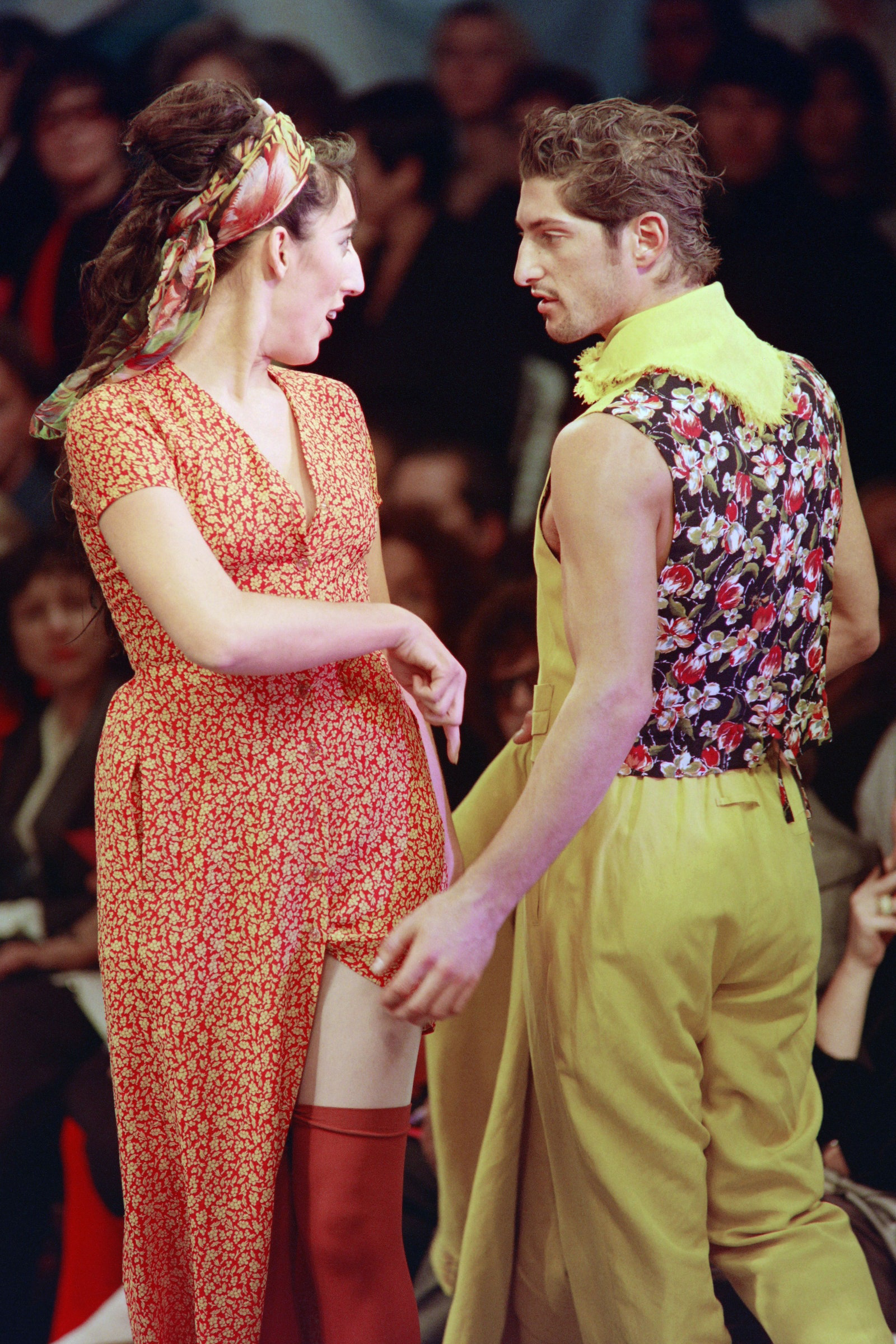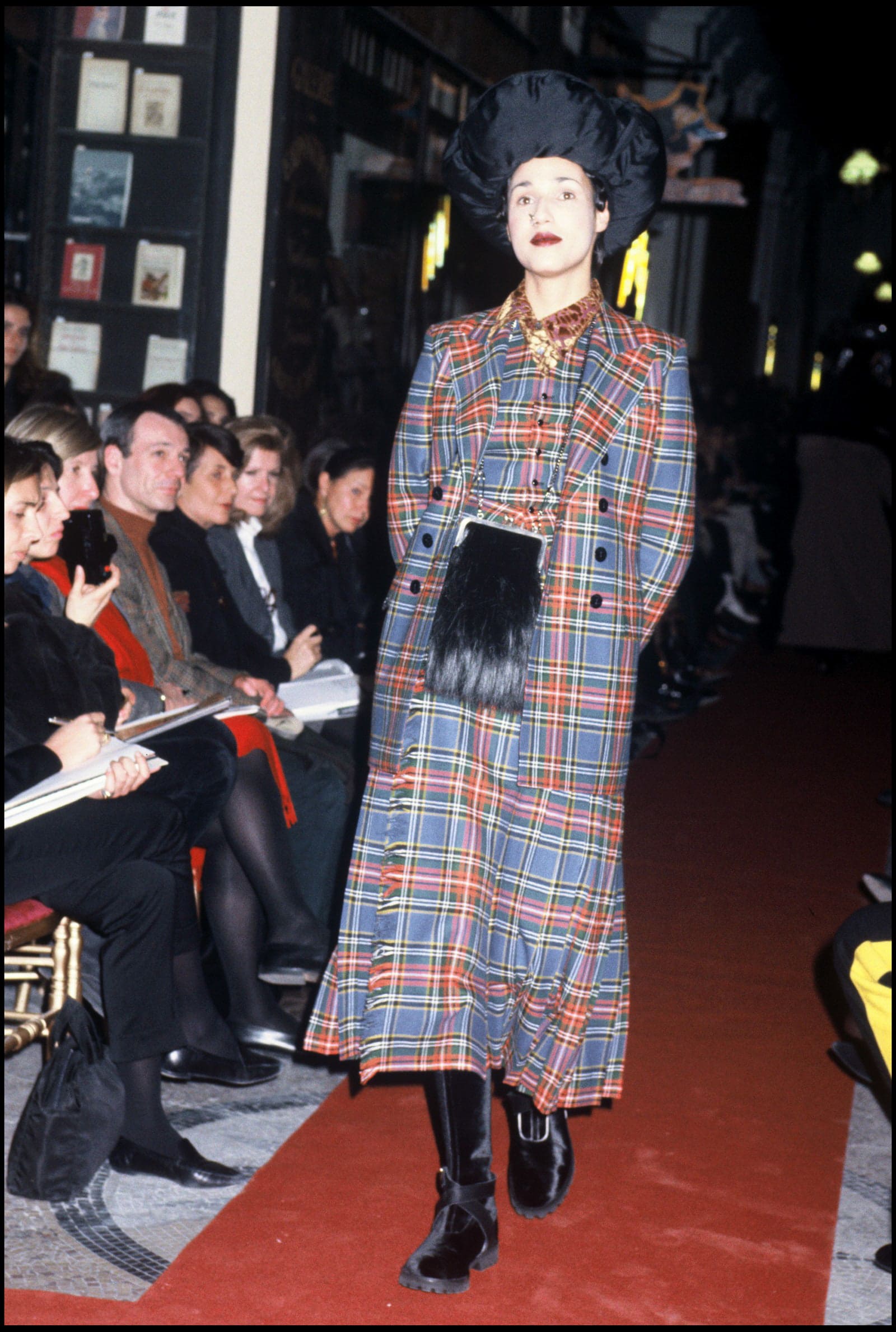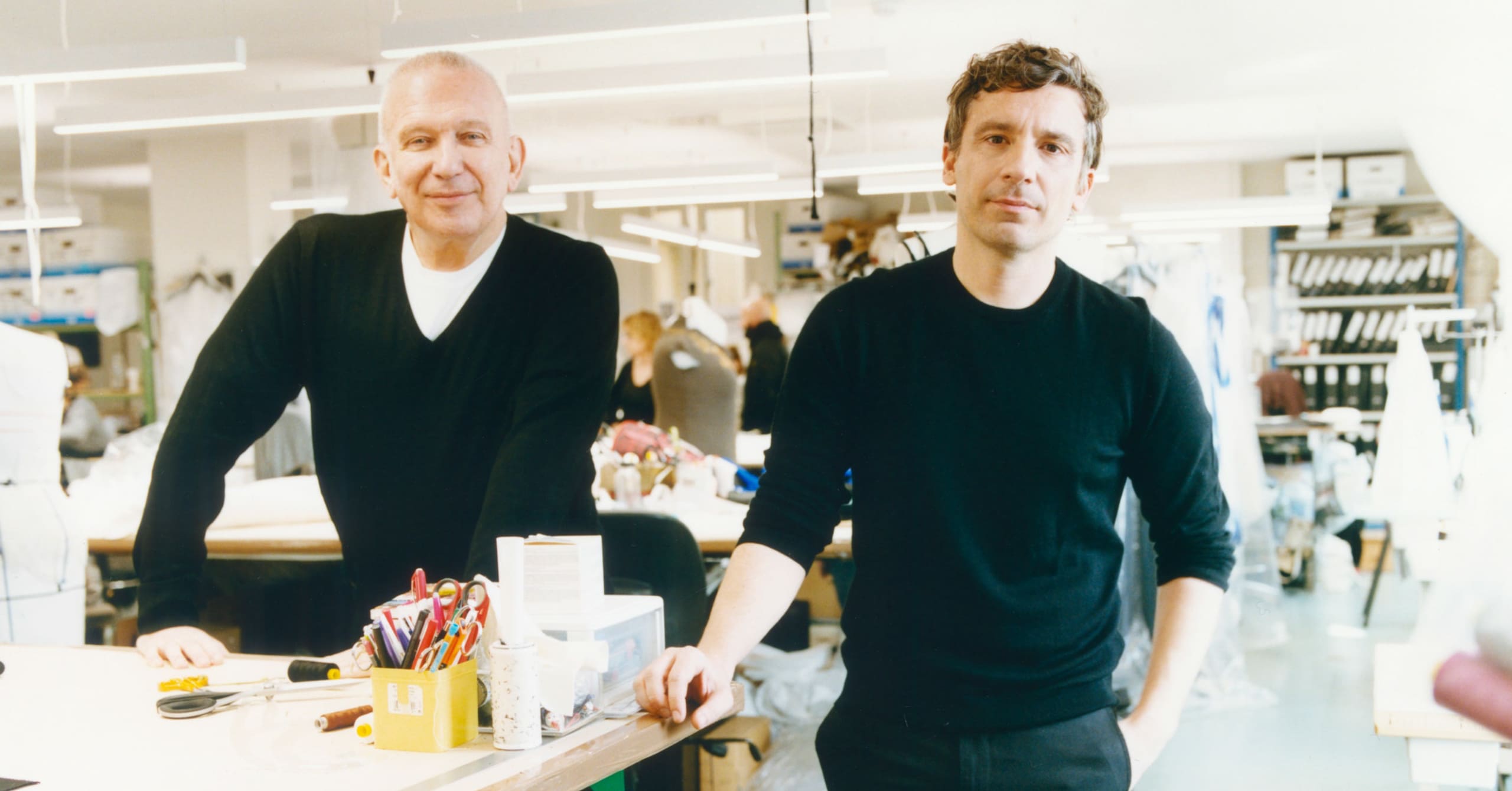Jean Paul Gaultier and Julien Dossena Photo: Maciek Pozoga / Courtesy of Jean Paul Gaultier
Jean Paul Gaultier and Julien Dossena Photo: Maciek Pozoga / Courtesy of Jean Paul Gaultier
Julien Dossena, who marks his 10th anniversary as creative director of Paco Rabanne this year, will be the fifth guest designer to present a couture collection for Jean Paul Gaultier. It’s the first time Puig, the group that owns both houses, has drawn from its own ranks.
From his home in the Basque region of southwestern France, Gaultier told Vogue, “what stands out about Julien is his personality. He is brilliant, generous, creative.” The couturier had equally fond words for Paco Rabanne, who passed away last month at 88. “Paco and I often crossed paths in St. Jean de Luz, a city we both loved. I had the good fortune of appreciating his joy, his humor, and his good mood.” Gaultier also praised Rabanne’s way of “playing with unexpected, futuristic and innovative materials and making them into signature pieces that have endured through the ages. He was one of the forerunners of the avant-garde fashion of the ’60s, a true master of the art.”
Puig, which this week posted record revenue of €3.62 billion for 2022, declined to break out numbers for sales of Gaultier’s guest designer collections. But Antoine Gagey, CEO of Jean Paul Gaultier, said, “every season has been a tremendous success in terms of communications and sales. Our intention is to reinvent ourselves for each collection (…) with the aim of surprising our community and customers. This new collective approach matches Jean Paul Gaultier’s DNA perfectly considering the richness of the archives and the plurality of his codes.” The model, he added, gives the brand an opportunity to attract new customers from different regions and generations who are eager for couture by Gaultier’s guests.
For Dossena, who follows Haider Ackermann, Olivier Rousteing, Glenn Martens, and Chitose Abe as guest designer, the Gaultier collaboration brings a couture debut and a chance to change register; unexpected materials may still be in the mix, he said during an exclusive interview with Vogue. This conversation has been condensed.

Hi Julien, congratulations! What’s your first memory of Jean Paul Gaultier’s work?
Jean Paul was a hero of my childhood. I think he’s the first designer I saw on TV—because he’s popular everywhere, but especially in France—explaining his métier in a way I understood, given that I grew up in a small town and my family is not at all in fashion. That was the first time I realized that being a designer, a couturier, designing clothes was a profession. That really gave me the first inkling of what I wanted to do, without knowing exactly what form it might take. So he’s very fundamental for me, and I think I’m in good company because for my generation he’s someone who mattered a lot, and still does, in the way we see things.
What about Gaultier’s process speaks to you the most?
It was his way of making this profession, or at least the idea of it, accessible. His generosity of expression and pleasure are pretty contagious. He’s all about generosity of sharing, and having fun too. And being fearless, doing things instinctively, with tremendous culture but at the same time always offering up a certain idea of individuality, newness, and modernity.
For me as a teen, and later as a [fashion] student, that was always a path to follow. And it still is in the way I work today. What I’ve always loved about Jean Paul’s approach is his constant curiosity, his way of exploring different registers and tastes. There are no boundaries to what he does: for some designers, a jacket is a jacket and it stays the same for 40 years. With Jean Paul, there’s this sense of no limits, no borders, and no holding back, which I find very generous and audacious. It’s as if he were always putting himself in danger by proposing something new or exploring another individuality. He was a pioneer in questions of gender, of accepting difference, and multiculturalism—all questions that resonate even more today—but he did it in a way that was almost instinctive. I find that gift of expression to the world very beautiful.
In terms of your own process, what qualities do you think you share with Gaultier?
Maybe it’s because I’m fortunate enough to work at Paco Rabanne, but I think in my process I also have that idea of constant exploration. Finding a proposition with a certain radicality; not being too literal, giving things a twist—or maybe it’s an idea of elegance that’s open to different possibilities. It’s his curiosity, in any case, that I find touching. I’m not sure I’m at the same “no-limit” level, but it’s something I find interesting as a potential point in common.
How did this collaboration come about, given that you’re both in the same corporate stable?
It came from the group. I knew about the seasonal guest designer and that I’d been considered for some time, but it’s precisely because we’re in the same group they didn’t want me to be among the first, so it wouldn’t look obvious. They knew I’d love to explore the Gaultier universe, because it’s always inspired me. So it all came about naturally. What was important to me was to know whether he liked the idea, and apparently he did. There was no big family meeting, it was very easy and fluid.
You’ve had a stellar run at Paco Rabanne, and this year marks your 10th anniversary. While this carte blanche for Jean Paul is a completely different exercise in terms of personalities, style, and era, it’s a variation on that theme. What are the differences in how you’ll approach Gaultier versus Paco Rabanne?
For Paco Rabanne, the principle was different: it was a brand that didn’t really exist anymore in fashion, and in the beginning there were limited expectations because it was a long-term project. It was really: how do we establish a new vocabulary for this house while, obviously, respecting the DNA and trying to open it to the present. Because the house was really about niche techniques—which are really important—with mesh and metals. Here, it’s another story because I’m a guest at Jean Paul Gaultier. It’s a one-shot. So I loved meeting his team, which has a completely different way of working than my team at Paco Rabanne, and learning how they do things and finding that balance between what I can inject into or take from Gaultier, and what his team can bring. I’m always asking them how he did things, why he transformed that dress. Picking up on his process and doing it well can make the exercise successful. So it’s like the first day of school, meeting people and trying to see how things will go. I have great teams at Paco Rabanne, it all functions really well, but this is really refreshing for me. It’s a different freedom and a different feeling.
Given the depth of his archives, how do you pick where to start?
Some collections are really fundamental for me, they made a huge impression even when I discovered them after the fact. The Chic Rabbi collection (fall 1993) was incredible for its volumes, in the nobility of the subject, and at the same time in its modernity, its elegance. I thought the balance was perfect. I also love the Constructivists (fall 1986) for its magnificent mix of knits, with inscriptions, the paillettes all mixed together, the hybridization of pieces, the motorcycle dresses in very Bauhaus colors. Also, beyond the clothes, I adored certain principles of the shows: there was one called Adam and Eve that I thought was fantastic, where couples appeared on the runway with this idea of mix-and-match silhouettes that I found very beautiful. I could go on for hours. It’s an extremely rich heritage, which goes back to generosity and exploration. In terms of excellence, he covered it all. Right now, I’m spending entire days in the archives, it’s fantastic. It’s like having a chance to create a personal exhibition. And in terms of codes, his work with corsetry and lingerie in general are among the most beautiful pieces I’ve ever seen. That’s where you see the couturier, the nobility of the clothes and a technique that’s very impressive.

How does it work? Will Jean Paul really discover the collection at the same time as the rest of the fashion world?
Yes, he wants the fun of being surprised, so he lets us be. And I think that’s a form of generosity, too—no one does that. It’s deeply polite to leave us that freedom, because freedom is important to him too. I think for him, creation can only happen in a space of no limits.
Are you considering sustainable materials, or upcycling, for this collection?
Very honestly, we’re thinking about that right now, since we’re ordering materials. Since this is couture, it’s obviously about orders, and you can do that with this kind of collection. The idea was to start with vintage and re-integrate it, place it at the heart of the work. But that takes a lot of scouring the fleas, vintage dealers—you need stock. We’re looking at how to incorporate the principle, which I find very interesting. We’ve all been thinking about those questions for several years now. Beyond that, upcycling was also something that Jean Paul practically invented, or in any case pioneered. I’m seeing pieces that were reworked four times for different collections, bases that were re-cut as a skirt, as a jacket, etc. I find that desecration of his own work really beautiful and liberated.
Are the archives intact?
They’re very well organized—Clara, who manages them, has done an exceptional job. What’s great about Gaultier is that these are living archives—the pieces go on display, they’re worn for concerts, they continue to exist. Unlike other archives I’ve known at other houses, there’s a real balance between preservation and letting the clothes live on. I imagine that’s how Jean Paul wanted to use his legacy.
When did you first meet Jean Paul?
I’m not sure he remembers. It was on a shoot for a magazine, a special issue guest-edited by Nicolas Ghesquière where he rounded up all his friends in the business. Since Nicolas started with Jean Paul at 18, he was there too and we met on the set. We spoke briefly. He was very kind, and now that I know him a little more I can say he was very himself. Now we speak at greater length, and I consider myself lucky to have spent time with him and talked about different things, life in general, how he sees the métier of being a designer, how he speaks about fashion, his path, his passion. He doesn’t give advice, we just talk.
What for you is the biggest challenge in fashion right now?
Actually, never losing the principle of pleasure. We know that it’s a very demanding industry, that’s very competitive, that’s sometimes based on power, possibilities, etc. So it’s about never losing sight of the fact that’s it’s a fantastic métier, which can get lost in all those considerations—the pressure, the responsibilities, constant competition and a super fast pace that demands enormous amounts of energy and attention. It’s the constant challenge: remembering with every collection, with every proposition how lucky we are to be here and to keep on. Especially once you’ve been around a few years. You get up in the morning, you have a team you love, you love working on that particular dress right now, or doing research, or meeting someone you want to dress and who wants to be part of what we do, and to always be connected with the world. As a designer, that’s the very personal challenge of the job.
What’s the balance for staying true to a voice, a vision, a spirit—and then bringing yourself into the mix?
With Jean Paul Gaultier it’s really simple because it’s so contemporary and modern that there’s no relation to a time and how to translate that for now. I could practically take some pieces and put them right back on the runway. It still works. Paco Rabanne was very anchored in the ’70s, so that’s about sending a different message. In the end it’s about respect, for work and for a way of working. Finding that exact balance between what you can bring—a love for your work—and at the same time being transported by Jean Paul Gaultier’s spirit and way of working. Being invited into someone’s house is a form of politeness, so the idea is letting yourself be traversed by that and not vice-versa.
In all modesty, what traits do you think you share?
Curiosity, a certain idea of pleasure, lightness and having fun. Also, the idea of fearless self-expression, in different registers, and having fun with the idea of taste that’s not necessarily [just defined by] Paris, fashion, minimalism. Of putting yourself potentially in danger, but going and exploring something that interests you in the moment.
And differences?
There’s a shared culture but also a different one. Not having the same interests is what makes it compelling—it lets you shake things up. From a cultural point of view, we’re of different generations so I imagine that potentially we don’t see certain things the same way. Jean Paul has already explored everything. He’ll keep expressing himself, of course, but in other domains. In terms of differences, we’re not at all at the same stage of accomplishment.
Julien Dossena will show his collection for Jean Paul Gaultier in July.
This article was originally published on Vogue.
